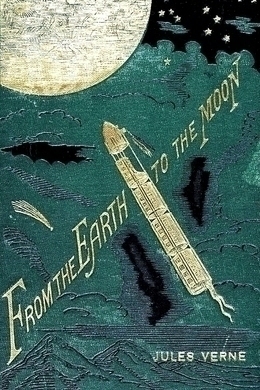
From the Earth to the Moon and 'Round the Moon
Volume I & II of the Moon Voyage, illustrated
by Jules Verne
subjects: Classic Science Fiction
series: Extraordinary Voyages (#4)
-
EPUB 3.03 MB
-
Kindle 2.60 MB
-
Support epubBooks by making a small $2.99 PayPal donation purchase.
Description
This is the legendary novel of technological speculation and social satire that launched an entire genre of adventure fiction: Verne’s From the Earth to the Moon and ‘Round the Moon is the first story of space exploration and remains a beloved work of daring exploits-and surprisingly accurate scientific conjecture. When the members of the Baltimore Gun Club-bored Civil War veterans-decide to fill their time by embarking on a project to shoot themselves to the moon, the race is on to raise money, overcome engineering challenges, and convince detractors that they’re anything but “Lunatics.” With this work, Verne inspired the first science fiction film, 1902’s Le Voyage dans la lune, and accurately predicted that that ideal location for a space base is in Florida. This is the original 1873 Mercier and King translation.
363 pages with a reading time of ~5.75 hours (90792 words), and first published in 1865. This DRM-Free edition published by epubBooks, 2009.
Community Reviews
There are currently no other reviews for this book.
Excerpt
During the War of the Rebellion, a new and influential club was established in the city of Baltimore in the State of Maryland. It is well known with what energy the taste for military matters became developed amongst that nation of ship-owners, shopkeepers, and mechanics. Simple tradesmen jumped their counters to become extemporized captains, colonels, and generals, without having ever passed the School of Instruction at West Point: nevertheless, they quickly rivalled their compeers of the old continent, and, like them, carried off victories by dint of lavish expenditure in ammunition, money, and men. But the point in which the Americans singularly distanced the Europeans was in the science of gunnery. Not, indeed, that their weapons retained a higher degree of perfection than theirs, but that they exhibited unheard-of dimensions, and consequently attained hitherto unheard-of ranges. In point of grazing, plunging, oblique, or enfilading, or point-blank firing, the English, French, and Prussians have nothing to learn; but their cannon, howitzers, and mortars are mere pocket-pistols compared with the formidable engines of the American artillery. This fact need surprise no one. The Yankees, the first mechanicians in the world, are engineers—just as the Italians are musicians and the Germans metaphysicians—by right of birth. Nothing is more natural, therefore, than to perceive them applying their audacious ingenuity to the science of gunnery. Witness the marvels of Parrott, Dahlgren, and Rodman. The Armstrong, Palliser, and Beaulieu guns were compelled to bow before their transatlantic rivals. Now when an American has an idea, he directly seeks a second American to share it. If there be three, they elect a president and two secretaries. Given four, they name a keeper of records, and the office is ready for work; five, they convene a general meeting, and the club is fully constituted. So things were managed in Baltimore. The inventor of a new cannon associated himself with the caster and the borer. Thus was formed the nucleus of the “Gun Club.” In a single month after its formation it numbered 1833 effective members and 30,565 corresponding members. One condition was imposed as a sine qua non upon every candidate for admission into the association, and that was the condition of having designed, or (more or less) perfected a cannon; or, in default of a cannon, at least a firearm of some description. It may, however, be mentioned that mere inventions of revolvers, five-shooting carbines, and similar small arms, met with but little consideration. Artillerists always commanded the chief place of favour. The estimation in which these gentlemen were held, according to one of the most scientific exponents of the Gun Club, was “proportional to the masses of their guns, and in the direct ratio of the square of the distances attained by their projectiles.” The Gun Club once founded, it is easy to conceive the result of the inventive genius of the Americans. Their military weapons attained colossal proportions, and their projectiles, exceeding the prescribed limits, unfortunately occasionally cut in two some unoffending pedestrians. These inventions, in fact, left far in the rear the timid instruments of European artillery. It is but fair to add that these Yankees, brave as they have ever proved themselves to be, did not confine themselves to theories and formulæ, but that they paid heavily, in propriâ personâ, for their inventions. Amongst them were to be counted officers of all ranks, from lieutenants to generals; military men of every age, from those who were just making their début in the profession of arms up to those who had grown old on the gun-carriage. Many had found their rest on the field of battle whose names figured in the “Book of Honour” of the Gun Club; and of those who made good their return the greater proportion bore the marks of their indisputable valour. Crutches, wooden legs, artificial arms, steel hooks, caoutchouc jaws, silver craniums, platinum noses, were all to be found in the collection; and it was calculated by the great statistician Pitcairn that throughout the Gun Club there was not quite one arm between four persons and exactly two legs between six. Nevertheless, these valiant artillerists took no particular account of these little facts, and felt justly proud when the despatches of a battle returned the number of victims at tenfold the quantity of the projectiles expended.
